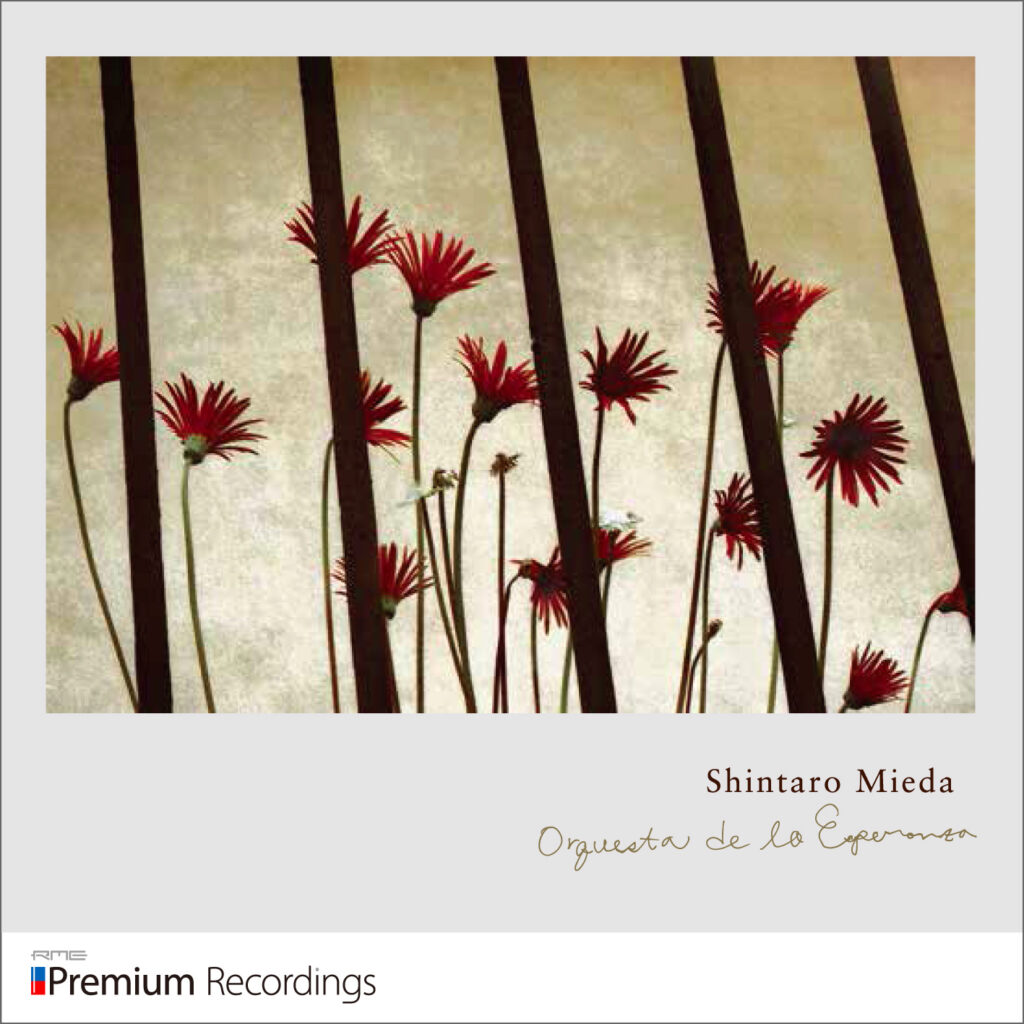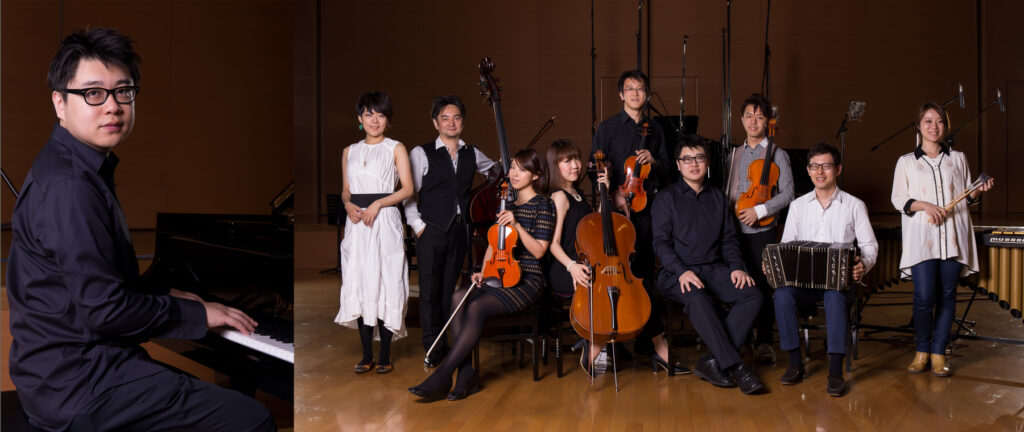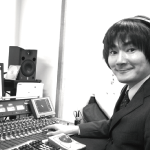Shintaro Mieda – Orquesta de la Esperanza
The extraordinary debut album from the ensemble led by Shintaro Mieda, a pianist who is known for crossing genres to create “21st century chamber music.”
Orquesta de la Esperanza is a chamber music group that plays in the tango style and primarily performs original pieces by Shintaro Mieda, an innovative composer whose work includes several film and incidental music scores. The group debuted as a six-piece in April 2014. After several public performances, mainly at the Zoshigaya tango bar El Choclo, they performed for the first time as an eight-piece at Shibuya’s Koen-Dori Classics in January 2015. The group’s members are drawn from present-day Japan’s most popular young tango performers. Mieda’s pieces skillfully fuse a firm classical foundation with a sophisticated and nostalgia-tinged Latin essence to weave rich and colorful narratives, all performed in an invigoratingly bright manner worthy of the “esperanza”(hope) in the album’s name.

Shintaro Mieda – Orquesta de la Esperanza
Streaming
Album Overview
Shintaro Mieda, Orquesta de la Esperanza
Performed by: Shintaro Mieda, Orquesta de la Esperanza
Recorded on May 29, 2015, at Kanagawa Kenritsu Sagamiko Kouryu Center
Track List
| 1 | Spring is coming | |
| 2 | Peregrinación | |
| 3 | Suite “Kibo no Kisetsu” – Overture | |
| 4 | Suite “Kibo no Kisetsu” – Sakura no | |
| 5 | Suite “Kibo no Kisetsu” – Natsu no Futatsu no Yokogao 1 | |
| 6 | Suite “Kibo no Kisetsu” – Natsu no Futatsu no Yokogao 2 | |
| 7 | Suite “Kibo no Kisetsu” – Shiokaze to Parade | |
| 8 | “Wasurenai to Chikatta Boku ga Ita” | |
| 9 | El Mar en Los Ojos | |
| 10 | Libertango | |
| 11 | At the sky in Moscow |
Shintaro Mieda, Orquesta de la Esperanza
Digest cut
Shintaro Mieda, Orquesta de la Esperanza
Peregrinación
“The Music of Hope: Thoughts on the First Album,” by Mitsutaka Nagira (music journalist)
The first album by Shintaro Mieda and Orquesta de la Esperanza has arrived. With the exception of Piazzolla’s Libertango, it consists entirely of original pieces composed by Mieda, and is an album overflowing with invigoratingly bright performances worthy of the word “esperanza” (hope) in its name.
With the composer himself behind the piano, the remainder of the core sextet consists of bandoneon and a string quartet. They are also joined at times by guest performers on contrabass, percussion, and vocals. The Orquesta de la Esperanza players are all prominent figures with a grounding in and knowledge of classical technique, a foundation which they use to transform and deliver the rich, colorful stories woven by Mieda’s scores as an energetic sound. Rather than the stiflingly sensual atmosphere one might encounter at a tanguería in Buenos Aires, the sophisticated compositions have a beautiful sonority at their core, but the breathtakingly thrilling tension sustained at the climax of each performance is evidence of the players’ skill and the high dimension on which they operate as an ensemble.
To date, most of the compositions Mieda has released into the world have been in the service of films or theater, and the collection of pieces on this album also leaves a visual, almost painterly impression. The sensory words he uses to describe his creations, ranging from “soft rain” to “the smell of wind” or “between winter and summer,” each summon concrete pictures in our visual imagination. According to Mieda, the performance at the center of the album, a 30-minute tour-de-force called “Suite ‘Kibo no Kisetsu,'” is “a depiction of the period spanning from the end of spring to summer in the aftermath of The 2011 Tohoku Earthquake and Tsunami.” In keeping with this theme, the music evokes the cycle of life at the heart of the changing seasons and instills listeners with the image of all lifeforms moving in concert and blending together as one. Mieda himself writes of his personal experiences on 3.11 as “death and rebirth, but in a form unlike before.” But while it engages in self-reflection and mourning, the music also keeps a firm eye on the seeds of hope. It leaves one feeling as if they were standing alone at the end of summer in a vast, bountiful field of ripened rice ears kissed by the glow of sunset, and the breeze that blows through the listener’s heart is endlessly refreshing.
The high degree of purity with which Kazuya Nagae has impressively captured the musical landscape created by Shintaro Mieda and Orquesta de la Esperanza is (despite having already been demonstrated by Nagae’s other output) more evident than ever on this recording. Neither the firm tone clusters born from the precise pitch of the stringed instruments nor the horizon that unfolds from the overlapping harmonics possess a degree of muddiness, and the results seemingly render the layered acoustic structure of Mieda’s score fully transparent. In addition, with every appearance of the bandoneon, an instrument whose reeds are activated by wind produced from oscillating bellows, we can feel the flow of the sharpened air as it passes by. This chain of sound is truly alive and aids in the birth of organic music. Overall, this is an album that allows listeners to experience the happiness of immersing themselves in the sublime atmosphere created by a composer and engineer who have mastered the art of sound.

Shintaro Mieda
(composer, pianist)
Mieda was born in 1985 in Kanagawa Prefecture and completed his Master of Music at the Graduate School of Tokyo College of Music, majoring in composition. Beginning in 2008, he participated in concert tours and recording sessions with bandoneon player Ryota Komatsu. In 2011, he joined the Naoki Kita Quartet as pianist, earning high praise for his uniquely beautiful and, at times, fierce playing style, which included string piano. As a composer, he has contributed music for several films and theatrical performances, and, in 2015, he served as pianist, arranger, and musical director on “Reijin,” the 2015 concert and CD album project by former members of the Takarazuka Revue. His film scores include the movies Wasurenai to Chikatta Boku ga Ita, The Garden of Sinners, and Sentimental Yasuko. He formed Shintaro Mieda – Orquesta de la Esperanza in 2014 with the primary goal of performing his own compositions, and the group has continued releasing original music that combines modern tango and jazz with contemporary elements.
Satoshi Kitamura
(bandoneon)
Born in 1979 in Nara Prefecture. Kitamura first encountered the bandoneon while attending Kansai University and became a student of Ryota Komatsu. After appearing in several concerts and tango festivals both in Japan and abroad, he was selected by former Ástor Piazzolla Quintet pianist Pablo Ziegler to join his Asian team. He has also participated in recording sessions for several NHK dramas, including Ryômaden, Carnation, and Yae no sakura. In September 2014, he earned high praise for his ambitious B to C program at Tokyo Opera City, which extended beyond classical tango and Piazzolla.
Atsushi Yoshida
(violin)
Born in Yamaguchi prefecture. Yoshida began playing violin at the age of four and was ranked number one at the Student Music Concours of Japan competition in Fukuoka. He began playing tango while attending Tokyo University of the Arts. He has participated in bands such as Ryota Komatsu & the Tanguists and Machiko Komatsu & Tango Cristal. After graduating with a degree in musicology from Tokyo University of the Arts, he completed his master’s degree at the graduate school of the same university, majoring in viola. He is currently a part-time lecturer with the Geidai Philharmonia Orchestra.
Natsumi Okimasu
(violin)
Born in Onomichi City, Hiroshima Prefecture. Okimasu studied under Hideo Kojima, the late Chikashi Tanaka, Chiyoko Noguchi, and Natsumi Tamai. She was selected as best performer at the 15th Chugoku Youth Music Contest. In 2008, she graduated from the school of music at Tokyo University of the Arts with a major in violin. During that time, she received a two-year Nakamura scholarship in music from the Hiroshima International Cultural Foundation starting in 2004. In 2009, she joined Machiko Komatsu & Tango Cristal, and devoted herself to studying tango under the guidance of the prominent tango pianist Machiko Komatsu. She also received an honorable mention at the 2010 International Neo Classical Competition.
Atsuki Yoshida
(viola)
Born in Ogaki City, Gifu Prefecture. Yoshida graduated with highest honors from Tokyo College of Music, majoring in violin. While attending classes there, he played both violin and viola. He also took part in studio work and performed in musicals. He has appeared alongside artists such as Ryuichi Kawamura, Ayaka, Hikaru Utada, and Yuta Furukawa. As a tango performer, he has played with Ryota Komatsu and as a member of the Orquesta Tipica Pampa, led by Yuzo Saito. He has also earned attention for Gali x Buli, a unique duo he formed with contrabassist Seiya Yoshida, as well as innovative collaborations in the fields of tap dancing, jazz, gypsy music, and more.
Yumi Shimazu
(cello)
Born in Osaka. Shimazu began playing cello at age six and attended Tokyo University of the Arts, where she graduated in 2006. She has studied under the late Minoru Sugiyama, Mineo Hayashi, and Kaeko Mukoyama. Beginning with chamber music and orchestral work, she has performed in a wide range of genres and contributed to recordings by several artists. She has also released eight CDs as a member of various musical units.
※Guest Artists
Toru Nishijima
(contrabass)
Born in 1973 in Tokyo. Nishijima began playing violin at age five and took up the electric bass in high school. He switched to contrabass after graduating from the engineering department of Nihon University. The artists he has supported include Jazztronik, Pablo Ziegler, Karen Aoki, Hiromitsu Agatsuma, Kousuke Atari, Chie Ayado, Hiroko Williams, Lisa Ono, Carmen Maki, Yoshiko Kishino, Ryota Komatsu, Tatsuo Sunaga, Mika Nakashima, Taro Hakase, Kiyoshi Hasegawa, Iwao Furusawa, and Wasaburo. In March 2014, he and pianist Masaki Hayashi released their second album as a duo, El retratador.
Hitomi Aikawa
(percussion)
Aikawa graduated from the percussion department of Tokyo University of the Arts in 2006. She has studied percussion under Ryoichi Kayatani, Makoto Aruga, and Takafumi Fujimoto. In 2007, she was awarded second place (there was no first place) in the duo category at the Plovdiv International Percussion Competition. She also appeared on the Kōhaku Uta Gassen in 2013 as a member of Otomo Yoshihide & Amachan Special Big Band. Her work as a multi-percussionist extends across a wide variety of genres and events.
Tomomi Oda
(vocals)
Born in Kanagawa Prefecture. After studying composition at Kunitachi College of Music Junior & Senior High School, Oda was admitted to and graduated from the Department of Composition at Tokyo University of the Arts in March 2013. In addition to her solo career, her diverse work with groups includes playing keyboards for DCPRG, composing music for the collaborative poetry and music group Voice Space, and playing piano across Japan in performances with the famous tsugaru-shamisen player Chikuzan Takahashi II. Her first album, Go Gunning for Shaman, co-produced by Naruyoshi Kikuchi, was released in 2013.

Kazuya Nagae
(engineer)
After graduating from the Vocal Performance Course at Nagoya University of the Arts, Nagae began working at a recording studio. Following further employment at a TV and radio production company, he founded his own recording production company in 2000. In 2006, he became a full-time lecturer in Music Cultures & Education for the Music Division of Nagoya University of the Arts and was appointed assistant professor in 2014. Beginning in April 2012, he spent one year in Berlin, Germany, as a foreign research fellow for Nagoya University of the Arts and studied the “tonmeister” education model, which began at a German university in 1949. The model aims to develop specialists who have talent as both recording producers and balance engineers. Nagae’s efforts involved interacting with real German tonmeisters and participating in recording sessions ranging from orchestras to chamber music. He was recognized by the 21st Music Awards Japan (in the category of 2-channel non-packaged media) for the Hida Takayama Virtuoso Orchestra’s 2013 concert, the first release in the RME Premium Recordings series.
 Listen on AWA
Listen on AWA
